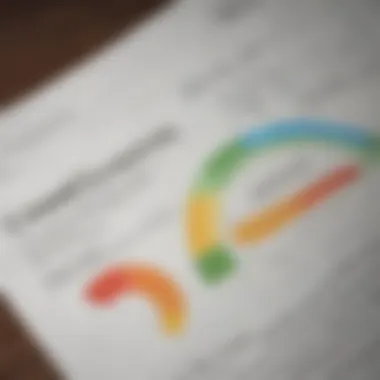Understanding Closed Student Loans and Their Effects


Intro
As the nuances of financial obligations evolve, the subject of closed student loans stands as a focal point for many borrowers. How these loans are managed, their implications on credit health, and the various pathways available post-closure can significantly affect one’s financial journey. Whether one has graduated or chosen to change their course of study, understanding what it means for student loans to be marked as closed is crucial.
Student loans can be closed for several reasons, such as full repayment, loan discharge, or even default. Each of these scenarios comes with its distinct set of consequences that can influence a borrower’s overall financial landscape. Beyond the immediate implications for credit scores, there are long-term considerations regarding financial planning and future borrowing capabilities.
In this article, we aim to unpack these complexities and shed light on the often-overlooked aspects associated with closed student loans. By doing so, we empower borrowers to make informed decisions that align with their financial goals, ultimately leading toward more sustainable financial health.
Preamble to Student Loans
Student loans serve as a crucial financial tool for many individuals aiming to enhance their education and career prospects. In a world where higher education has become increasingly tied to job opportunities and earning potential, understanding the intricacies of student loans is essential. Borrowers need to grasp not only the types of loans available but also the implications of their decisions throughout the loan lifecycle. As student debt reaches significant levels nationwide, shedding light on closed loans becomes pertinent. Closed loans often signal the culmination of the borrower's financial journey and can influence future borrowing ability and credit profile.
Purpose of Student Loans
The fundamental purpose of student loans is to bridge the financial gap for education-related expenses. Many students face the dilemma of affording tuition, fees, and books. Student loans provide a lifeline that allows them to pursue their academic goals without immediate financial strain. Moreover, the lasting benefits of receiving a quality education can far outweigh the cost of borrowing, leading to higher salaries and job stability.
Types of Student Loans
Diving into the types of student loans unveils the landscape of financing available to students, each with distinct features and implications for borrowers.
Federal Loans
Federal loans, such as Direct Subsidized and Unsubsidized Loans, are often the first choice for many borrowers due to their relatively low interest rates and flexible repayment options. A notable characteristic of federal loans is the availability of income-driven repayment plans, which allow borrowers to adjust their monthly payments according to their financial situation. This is particularly advantageous for graduates entering a competitive job market where income may be uncertain.
With borrower protections like deferment and forbearance, federal loans stand out as a safer option, offering peace of mind should financial hardships arise. However, one must be aware of the potential for accrued interest, especially with unsubsidized loans that could grow while borrowers are in school.
Private Loans
Private loans, on the other hand, are issued by banks and financial institutions and can sometimes fill in the funding gaps that federal loans do not cover. A key aspect of private loans is their reliance on credit scores, which means that borrowers with better credit histories may receive more favorable terms. This makes private loans a viable option for some, particularly those pursuing graduate degrees where costs can soar.
However, private loans come with their challenges. Unlike their federal counterparts, these loans generally lack flexible repayment options and borrower protections. Additionally, variable interest rates can increase over time, leading to higher overall costs. Thus, while private loans can provide necessary funding, they often require careful consideration and a good understanding of their long-term implications.
What Does 'Closed' Mean?
Understanding what it means when a loan is marked as "closed" is pivotal for anyone dealing with student loans. This status signifies that a loan is no longer active, which carries significant implications for borrowers. The closure can occur due to several factors—most importantly, the completion of repayment or a discharge due to specific conditions, and grasping these elements is essential for navigating future financial landscapes.
Definition of Closed Loans
When we say a loan is "closed," we refer to a situation where no further payments are required, and the loan cannot be utilized for borrowing against. It means the borrowing relationship between the lender and borrower has ended. This does not necessarily imply that the journey was free of hurdles; for many, it represents a culmination of years spent managing financial responsibility—or, in some cases, a one-time act of mercy from a lender based on extenuating circumstances.
For instance, suppose a student borrowed funds under a federal program. Once they have paid off the entire amount or qualify for discharge conditions laid out by the loan provider, they could receive confirmation stating their loan is closed. In short, a closed loan means the associated debt has been settled, whether through repayment or through programs like Total and Permanent Disability Discharge.
Distinction Between Closed and Paid-Off Loans
It is crucial to differentiate closed loans from paid-off loans, as subtle yet significant differences exist. A paid-off loan technically falls under the umbrella of closed loans. However, not all closed loans imply satisfactory repayment without any complications.
- Paid-off Loans: This term exclusively refers to loans that have been fully repaid. Here, everything is straightforward; the borrower enjoys the peace of mind that comes with total debt clearance and is generally free from any lingering obligations to the lender.
- Closed Loans: This extends beyond simply having paid the balance in full. Consider loans that are closed due to discharge due to conditions such as a borrower’s inability to continue due to health reasons or a closed school scenario. These loans can close without the borrower ever making a single payment. Yet, even with this closure, consequences could still shadow the borrower’s credit score and financial history.
Understanding the difference can be akin to recognizing the shades of gray in life where black and white might be expected.
In summary, the term "closed loans" encompasses various scenarios and experiences. Knowing this distinction will better prepare borrowers to handle their finances and avoid misunderstandings that could impact their future borrowing capabilities.
Common Reasons for Loan Closure


Understanding the reasons behind the closure of student loans holds great significance. It provides borrowers with clarity and empowers them to make informed financial decisions. Closing a loan can stem from various scenarios, each carrying its own set of implications. It's crucial to dissect these reasons, as an insight into them can help borrowers navigate their financial landscape more effectively. Knowing why a loan is marked as closed not only aids in future planning but can also reveal potential benefits such as improving one's credit score or accessing forgiveness options.
Loan Repayment Completion
Loan repayment completion is one of the prime reasons for a loan being marked as closed. When borrowers faithfully fulfill their repayment obligations, they reach the finish line. This accomplishment isn’t just a relief; it symbolizes financial discipline and responsibility.
Borrowers who complete their loan payments not only eliminate debt but also free up future income for other priorities. Moreover, once a loan is closed due to repayment completion, it stands out as a positive account on one’s credit report, showcasing a history of timely payments.
In contrast, this closure signifies the end of a financial chapter, often leading to a more robust credit score and possibly better interest rates on future borrowing. It's like turning the page to a new and improved financial narrative.
Loan Discharge or Forgiveness
Loan discharge or forgiveness represents another pivotal reason that can lead to a loan’s closure. This process can vary widely depending on the circumstances and eligibility of the borrower. By understanding how these discharges work, one can appreciate their role in the broader context of student loan management.
Total and Permanent Disability Discharge
Total and Permanent Disability Discharge is a critical component of loan discharge decisions. This is pertinent for borrowers who can no longer maintain gainful employment due to a significant disability. The key characteristic of this type of discharge is that it absolves the borrower from repaying their federal student loans, which offers substantial relief in dire situations.
This discharge option is popular among those who face daunting health challenges. The unique feature lies in its requirement for borrowers to provide appropriate documentation, verifying their condition, which can sometimes be strenuous but ultimately worthwhile.
While the advantages of this discharge are clear—such as the relief from debt—it’s also essential to recognize the potential drawbacks. For instance, not every disability qualifies, and denial can lead to lingering financial distress. Moreover, there might be tax implications for the forgiven amounts, which add complexity to the situation.
Closed School Discharge
In cases where educational institutions shut down, Closed School Discharge becomes relevant. This route allows borrowers to have their loans discharged if their school closes while they are enrolled or shortly after withdrawal. The pivotal advantage here lies in justice: students should not be penalized financially for a school’s failure to provide an education.
The unique feature of Closed School Discharge is its applicability to a broad range of circumstances, including rapid school closures or significant operational issues. For many, this avenue offers a beneficial resolution to an unfair situation, breathing hope into those tangled in financial obligations.
On the flip side, navigating the process might involve some legwork—particularly in gathering necessary documentation to prove that the closure occurred under the right circumstances.
Consolidation of Loans
Loan consolidation stands as another reason for closure worth exploring. Borrowers often consolidate their loans to simplify repayments. This process can wrap multiple loans into a single, easier-to-manage loan, which can be a significan boon for someone juggling various payments.
This route not only streamlines finances but can also lead to lowered monthly payments, depending on terms and conditions. However, it’s worth noting that while consolidation may close existing loans, it can also reset the borrower’s repayment clock, extending the duration of repayment. Consequently, it becomes essential for individuals considering this option to weigh the pros and cons carefully against their long-term financial goals.
Impact of Closed Loans on Credit Score
Understanding how closed student loans interact with one's credit score is akin to piecing together a financial puzzle. While at first glance, it might seem like once a loan is closed, there’s nothing else to fret about. However, the ramifications of this closure can extend far into the financial future of a borrower. If you’re an investor, financial advisor, or even a borrower yourself, the implications are worth unpacking.
Understanding Credit Scores
Credit scores serve as the lifeline to future financial opportunities. They collate data on borrowing history, payment timeliness, and overall financial behavior to present a number typically ranging from 300 to 850. In most cases, a higher score is synonymous with better borrowing terms.
Here’s how it plays out:
- Payment History: This accounts for a significant chunk—35%—of your total score. If a student loan was closed due to timely payments, that record shines in a credit report.
- Credit Utilization: Ideally, keep this under 30% of available credit. Closed loans, especially if they were part of a balance, can alleviate some pressure here.
- Credit Mix: A healthy mix of credit types can boost the score. A closed installment loan adds to this mix, providing more leverage in negotiations with future creditors.
Yet, it’s essential to consider that closed loans don’t simply disappear from credit reports. They linger, offering a double-edged sword. Their significance must not be underestimated in this intricate web of financial relationships.
Effects of Loan Closure
Once loans are declared closed, various crucial effects ripple through a borrower's financial standing. One aspect to consider is how this closure might affect the credit score itself.


Positive Outcomes:
- Improved Ratio of Debt-to-Income: When a loan is closed, especially after complete repayment, this effectively lowers total liabilities, enhancing the debt-to-income ratio.
- Strengthened Credit Profile: Successfully closed loans can reflect a good payment record, building credibility for the borrower.
- Less Active Debt: Credit scores favor individuals who manage lesser current debt, so having loans closed can help create a more favorable context for future lending.
Negative Implications:
- Potential Credit Score Dip: In certain scenarios, closing a long-standing account might momentarily impact the credit score due to reduced available credit history.
- Loan History Consideration: Lenders may glance at closed accounts in assessing overall behaviors. If closures are perceived as indicative of repayment issues, lenders might be hesitant.
Key Insight: The impact of closed loans on credit isn't black and white; the nuances of credit score calculations illustrate the importance of understanding both benefits and potential downsides.
Navigating these elements carefully grants borrowers a foothold in the often confusing realm of credit scores, ensuring that they are well-informed as they make future financial choices.
What Happens After a Loan is Closed?
After a student loan has been officially marked as closed, it signifies not only the end of the repayment journey but also introduces a series of implications that borrowers need to consider. Understanding these outcomes is crucial—this knowledge can shape financial choices and future dealings with credit, potentially saving lenders and borrowers time and money in the long run.
Once closed, the implications can unfold in surprisingly complex ways, and navigating them might feel like walking through a minefield without a map. Yet, grasping what to expect can mitigate confusion and instill confidence. So, let’s unpack the nuances that arise post-closure.
Confirmation of Closure
The first step after a loan closure is receiving confirmation from the lender. This communication is more than just a formality; it serves as legal documentation that the loan in question has been paid off, discharged, or otherwise resolved. For a borrower, having this proof is critical for several reasons:
- Accountability: It ensures that the lender acknowledges the closure, eliminating potential future claims that may arise erroneously.
- Record Keeping: Essential for personal finance management. Keeping documentation helps in future audits or financial checks, reinforcing your reliability as a borrower.
- Dispute Resolution: In the unfortunate event that there is a discrepancy regarding the status of the loan, having formal closure documentation is a strong defense.
In this phase, paying attention to detail can save headaches. Borrowers should thoroughly review the confirmation for any discrepancies and keep it in a safe place.
Documentation and Records
Now comes the paperwork—an unavoidable aspect of finance. After closing a loan, every borrower has to deal with the aspect of documentation. The kind of paperwork involved tends to fall into a few key categories:
- Final Statements: These are summaries that outline how much was owed, how much was paid, and if there were any outstanding fees at the time of closure.
- Tax Implications: Records relating to interest payments can be required for tax deductions, especially for federal student loans. Knowing what to keep can lessen the tax burden later on.
- Credit Reporting: Once the loan is closed, the loan status must reflect accurately on credit reports, showing no ongoing obligation. Monitoring this is important.
Borrowers might feel overwhelmed by the piles of documents, but organizing them can be immensely beneficial. Establishing a systematic filing method—whether digital or physical—will facilitate quick access when needed.
"Documentation is the backbone of financial security; without it, you’re dancing on thin ice."
In summary, closing a student loan is not merely an endpoint. It opens up a new chapter filled with responsibilities and considerations regarding documentation, accountability, and record-keeping. By preparing thoroughly and understanding the implications, borrowers can steer past commonly encountered pitfalls, paving the way for future financial endeavors.
Future Financial Considerations
When discussing closed student loans, the ramifications extend well beyond the simple act of having the loan marked as finished. Understanding future financial considerations becomes indispensable not only for the borrowers themselves but also for financial advisors and educators who guide them. The closure of a loan reflects significant milestones and decisions, which can profoundly reshape one's financial landscape. It’s not just about freedom from debt; it can influence credit, enable new borrowing, and affect budgeting for years to come.
The intricacies of these implications can sometimes feel like a tangled web, but dissecting them unveils clear insights. Here are two key aspects to consider when evaluating how closed loans might affect future financial outcomes, specifically focusing on the impact on borrowing ability and debt-to-income ratios.
Impact on Future Borrowing
Closed loans may leave many borrowers wondering how their past decisions will affect their ability to secure new loans. Unlike an open loan, which could indicate ongoing financial obligations, a closed loan marks a moment of completion. This often paints a picture of financial responsibility—something lenders generally appreciate. As a result, borrowers who have managed their loans faithfully may find themselves in a more favorable position when applying for future credit.
However, it’s crucial to know that the closure of a student loan could also yield unintended consequences. For example, if a borrower has a history of defaults or if the loan was closed due to discharge or forgiveness, this may signal risk to potential lenders. These situations can skew calculations in loan approvals, leading to higher interest rates or even outright rejections.
Some other informs behaviors which lenders might observe include:
- Payment history on closed loans (were they paid responsibly?)
- Total outstanding debt as compared to total income
- Current employment status


In navigating new borrowing opportunities after loan closure, maintaining transparency with potential lenders is important. Being upfront about the reasons for loan closure and demonstrating your overall financial health can significantly improve approval chances.
Effects on Debt-to-Income Ratio
Another crucial element that emerges from the discussion of closed loans is their impact on the debt-to-income (DTI) ratio. This is a measurement used by lenders to ascertain a borrower's ability to manage monthly payments and repay debts. The DTI ratio is calculated by dividing total monthly debt payments by gross monthly income.
As closed student loans no longer represent an active obligation, they have the potential to lower the DTI ratio. A reduced ratio generally enhances the chances of securing new credit, as lenders often prefer a lower ratio. A borrower with a DTI ratio under 36% is frequently seen as a more astute candidate.
Here’s a simple breakdown to consider:
- If a closed loan decreases debt presented to lenders, the DTI ratio can improve.
- A favorable DTI ratio increases borrowing power, resulting in opportunities for home loans, auto financing, or credit cards.
Nevertheless, changing one’s DTI ratio is just part of the equation. Other factors also come into play, including income level, employment stability, and the overall credit history.
In sum, keeping a keen eye on the aftereffects of closed student loans can skillfully inform your financial strategies. This extends not just into loan management but into budgeting and future investing too. Closing a loan is somewhat like putting a full stop in a part of one's financial narrative, but it paves the way for a new chapter that requires attention, strategy, and sound decision-making.
Navigating Additional Questions
Understanding the nuances surrounding closed student loans is critical for borrowers as they plan their financial future. As important as closure is, it inevitably raises further queries that cut to the very heart of financial responsibility and opportunity. This section is dedicated to exploring these additional questions and providing clarity on issues that might linger post-closure.
Can Closed Loans be Reactivated?
Once a student loan is marked as closed, the prospect of reactivation not only depends on the nature of how the closure occurred but also on policies governed by the lender. Closed loans typically fall into several categories such as loans paid off, discharged loans, or those consolidated into new financing.
For many, the idea of a second chance might seem appealing—like getting a do-over in a game where stakes are high. However, the reality has to be navigated with precision. Generally, reactivation isn't standard practice. If the loan was discharged due to total and permanent disability, for example, the borrower's capacity to repay may be called into question. Reinstating such loans can be much more complicated.
A situation may arise, however, where a borrower regrets consolidation or simply feels the need to revisit their loan status. In such cases, borrowers should immediately contact their loan servicer to understand their options or the steps that could potentially allow for reinitiating the loan. Here are some considerations:
- Check Loan Type: Different loans come with varying rules.
- Consult the Lender: They can provide the most accurate and relevant information.
- Consider Financial Implications: Reactivation may carry fees or interest implications that could affect your financial wellbeing.
"Once the ship's sailed, it might be hard to get back to shore, but asking the right questions could help turn the tide."
Understanding Loan History Reports
Loan history reports serve as a financial resume for borrowers. They outline not just the closed loans, but the entire borrowing journey—detailing payment histories, outstanding balances, and more. For those with closed student loans, these reports can hold substantial information crucial for anyone looking to undertake new financial ventures.
Specifically, these reports are vital in assessing one's credit health and financial leash for future borrowing needs. Here's why understanding them matters:
- Credit Score Influence: Closed loans can still impact credit scoring even after being marked as closed, highlighting the importance of timely repayments.
- Insight into Financial Behavior: A healthy report with closed loans demonstrates good borrowing management.
- Implications for Future Loans: Lenders often depend on these reports to make informed decisions about extending credit.
Navigating these reports can sometimes feel like trying to find a needle in a haystack. Make it easier by frequently checking your report, ensuring it reflects your actual financial standing. Always look for inaccuracies—if you catch a discrepancy, report it; it's your financial future at stake.
In summary, mastering the landscape surrounding closed student loans is paramount. Understanding the possibility of reactivation and delving deep into loan history reports prepares you for what may lie ahead. It’s all about equipping yourself with knowledge, for knowing is truly half the battle.
Finale
Summary of Key Points
In summarizing the key points, several crucial elements emerge:
- Closure Definition: Understanding what denotes a loan as closed versus paid-off clarifies many common misconceptions.
- Reasons for Closure: Various situations such as successful repayment, forgiveness eligibility, or consolidation of loans lead to closure.
- Credit Score Impact: It’s important to recognize how a closed loan influences credit scores, either positively by reducing outstanding debt or negatively if the closure arose from default.
- Documentation and Records: Proper verification of the closure and maintaining records can aid in future financial interactions.
- Future Financing: Knowing how closed loans affect one’s ability to borrow in the future prepares borrowers to make informed financial decisions.
Final Thoughts
In wrapping up this exploration, remember that closed loans signify a chapter ended but not erased. They can serve as learning tools and references for financial planning.
Navigating the waters of student loans may seem daunting, but understanding these concepts empowers borrowers to chart their own course. Whether seeking another loan or assessing financial health, these considerations become immensely valuable.
As we reflect on these aspects, think of closed student loans not merely as an endpoint but as a motivator for sound financial practices. The knowledge gained equips individuals with the ability to make informed choices, unlocking potential that might otherwise have remained obscured.



